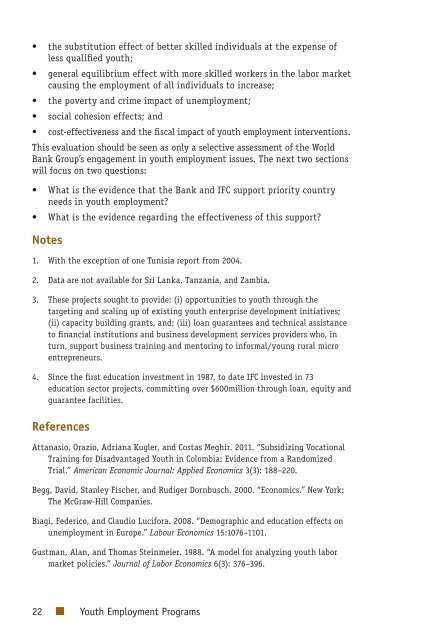- Page 5 and 6:
Youth EmploymentProgramsAn Evaluati
- Page 8 and 9: The Bank’s Impact Evaluations on
- Page 10 and 11: LACLICLILMBAMENANEETNGOOECDPADPCRPD
- Page 12 and 13: IEG management and colleagues provi
- Page 14 and 15: Youth Employment ChallengesIn gener
- Page 16 and 17: implemented 12 of the 90 operations
- Page 18 and 19: Kenya, entrepreneurship training fo
- Page 20 and 21: • Help countries design intervent
- Page 22 and 23: support to youth employment program
- Page 24 and 25: tive rules on hiring and firing as
- Page 26 and 27: Management Action RecordIEG Finding
- Page 28 and 29: IEG Findings and ConclusionsIEG Rec
- Page 30 and 31: IEG Findings and ConclusionsIEG Rec
- Page 33 and 34: Report to the Board from the Commit
- Page 35: could have focused more on the lack
- Page 38 and 39: • Chapter Highlights• High yout
- Page 40 and 41: and can afford to wait for a better
- Page 42 and 43: ConsequencesEarly unemployment is s
- Page 44 and 45: ReferencesBegg, David, Stanley Fisc
- Page 47 and 48: Chapter 2What Are the World Bank an
- Page 49 and 50: The strength and openness of the ec
- Page 51 and 52: Interventions to Address Youth Empl
- Page 53 and 54: commitments by the International Ba
- Page 55: Figure 2.2Top 12 Youth Employment I
- Page 61 and 62: Chapter 3What Is the Evidence that
- Page 63 and 64: school dropouts early. Learning opp
- Page 65 and 66: evaluations on what works best to p
- Page 67 and 68: Agriculture, Health, Education, Soc
- Page 69: Holzmann, Robert. 2007. MILES: Iden
- Page 72 and 73: • Chapter Highlights• The Bank
- Page 76 and 77: Argentina, Bulgaria, Colombia, and
- Page 78 and 79: facilitated 69 foreign work contrac
- Page 80 and 81: awarded vouchers to about 1,000 out
- Page 82 and 83: • Comparing the interventions ana
- Page 84 and 85: Hjort, Jonas, Michael Kremer, Isaac
- Page 87 and 88: Chapter 5Recommendations
- Page 89: farm self-employment and employment
- Page 92 and 93: This appendix presents the factors
- Page 94 and 95: Organization for Standardization (I
- Page 96 and 97: Box A.3Youth as a Demographic Divid
- Page 98 and 99: Table A.1Types of Youth Employment
- Page 100 and 101: Notes1. This phenomenon could be le
- Page 103 and 104: Appendix BEvaluation Data Sources a
- Page 105 and 106: Identification and Analysis of the
- Page 107 and 108: • Making the labor market work be
- Page 109 and 110:
Table B.3ApprovalFYList of Projects
- Page 111 and 112:
Table B.3ApprovalFYList of Projects
- Page 113 and 114:
Table B.4(I)nvestmentClimate(L)abor
- Page 115 and 116:
Table B.6List of Economic Sector Wo
- Page 117 and 118:
ment, Private Sector Development, a
- Page 119 and 120:
Other evaluations with outcome meas
- Page 121 and 122:
Table B.8CountryFranceKenyaMexicoPa
- Page 123 and 124:
Table B.8CountryUnitedStatesYouth E
- Page 125 and 126:
Table B.8CountryEuropeancountriesLa
- Page 127 and 128:
Bidani, Benu, Niels-Hugo Blunch, Ch
- Page 129:
Training Replication Sites.” Manp
- Page 132 and 133:
Appendix C provides additional info
- Page 134 and 135:
Box C.2Global Partnership for Youth
- Page 136 and 137:
ReferencesAedo, Cristian, and Ian W
- Page 138 and 139:
This appendix provides additional i
- Page 140 and 141:
The number of projects and total le
- Page 142 and 143:
Figure D.2World Bank Youth Employme
- Page 144 and 145:
Table D.5Intervention categoryYouth
- Page 146 and 147:
Table D.7Prevalence of Project Obje
- Page 148 and 149:
Table D.9Target Groups of Project O
- Page 150 and 151:
Table D.11Type of Interventions Sup
- Page 152 and 153:
Table D.13 Frequently Used Youth Em
- Page 154 and 155:
In sum, this portfolio review chapt
- Page 156 and 157:
approach in Turkey and Sierra Leone
- Page 158 and 159:
This appendix presents a detailed a
- Page 160 and 161:
to Finance business line, over a si
- Page 162 and 163:
entrepreneurship projects. Investme
- Page 164 and 165:
IFC has three types of investments
- Page 166 and 167:
Box E.1Africa Schools ProgramIFC su
- Page 168 and 169:
Box E.2e4e Initiative for Arab Yout
- Page 170 and 171:
3. IFC’s Advisory Services corpor
- Page 172 and 173:
This appendix presents lessons for
- Page 174 and 175:
Labor Market RegulationsLabor marke
- Page 176 and 177:
to the definition of unemployment b
- Page 178 and 179:
In post-conflict zones with small f
- Page 180 and 181:
Public works programs in Bank proje
- Page 182 and 183:
marginal impact of school-to-work t
- Page 184 and 185:
of the program. However, results fo
- Page 186 and 187:
• Weak results frameworks on the
- Page 188 and 189:
sustainability. Zambia’s TEVET pr
- Page 190 and 191:
unemployed youth registered with th
- Page 192 and 193:
for Employment and Entrepreneurship
- Page 194 and 195:
Note1. The Technical and Vocational
- Page 196 and 197:
Ibarraran, Pablo, and David Rosas.
- Page 198 and 199:
World Bank. 2012a. “World Bank an
- Page 200 and 201:
IEG’s Youth Employment Evaluation
- Page 202 and 203:
Figure G.1 Facebook Demographics Ba
- Page 204 and 205:
Figure G.3Results on Rural Employme
- Page 207 and 208:
BibliographyBarrera, Felipe, Paul G
- Page 209 and 210:
———. 2011b. Migration and Rem
- Page 211 and 212:
The World Bank GroupWorking for a W
















